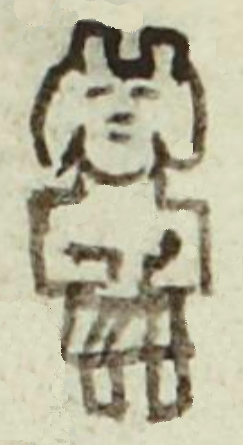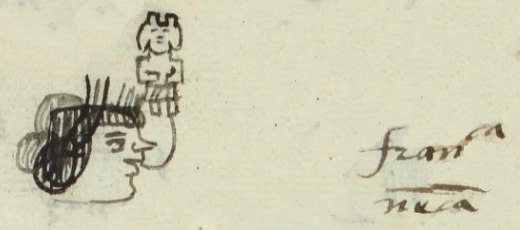Nenca (MH632v)
This black-line drawing of the simplex glyph for the personal name Nenca is attested here as a woman's name. Nenca ("Unemployed," or "Inactive"), refers to being idle or lazy. It shows a doll or an ixiptlatl, an image of a divine force, which were both apparently called (nenetl), along with women's genitals (according to Molina, but unattested in alphabetic Nahuatl manuscripts). This one has its arms across its abdomen and it wears a skirt. The glyph provides the phonetic start (Nen-) to the name. The -ca is not shown visually. Diagnostic traits for such anthropomorphic "nen" figures include two rectangular protrusions at the top of the head. They are also typically shown in a frontal view.
Stephanie Wood
The five extra days in the calendar of 360 days (xiuhpohualli) were called nemontemi (useless days). It was unlucky to be born on these days. A man who was born in this period was called nenoquich and a woman was called nencihuatl. This is explained in the Florentine Codex in Book 2, folio 12 recto (see: https://florentinecodex.getty.edu/book/2/folio/12r). These individuals were considered unlucky, ill-fated, and even useless. A great many individuals in the Matrícula de Huexotzinco have names beginning with the negative syllable Nen-. Perhaps they were born in that ill-fated period, or perhaps the negative syllable came to be even more liberally applied. With men, for instance, Nentequitl (perhaps a lazy worker) was much more common than Nenoquich. When presented visually, the nen- syllable could derive from nenetl (a figure or sculpture of a deity or a doll). Nenetl also had an association with women’s genitals, which has caused much speculation about a negativity associated with women and their sex, but that might have come from European religious influence. In the colonial context, such concepts and perceptions could become muddied.
Stephanie Wood
franca
nēca
Francisca Nenca
Stephanie Wood
1560
Jeff Haskett-Wood
widows, viudas, nombres de mujeres, muñecas, ixiptla, deidades, religión, imágenes

nenca, to be idle, without profit, https://nahuatl.wired-humanities.org/content/nenca
Desempleada, o Inactiva
Stephanie Wood
Matrícula de Huexotzinco, folio 632v, World Digital Library, https://www.loc.gov/resource/gdcwdl.wdl_15282/?sp=348st=image.
This manuscript is hosted by the Library of Congress and the World Digital Library; used here with the Creative Commons, “Attribution-NonCommercial-ShareAlike 3.0 License” (CC-BY-NC-SAq 3.0).











